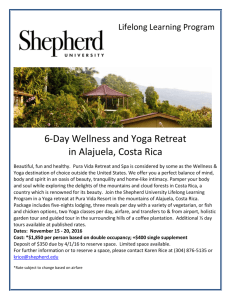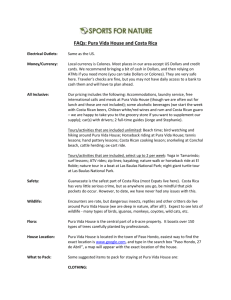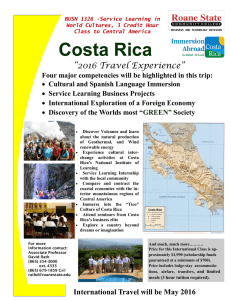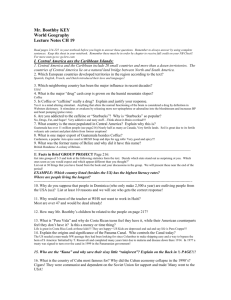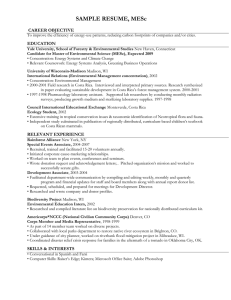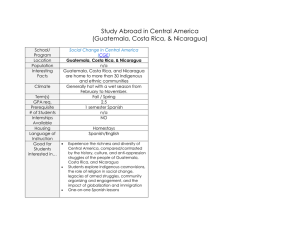T C G
advertisement
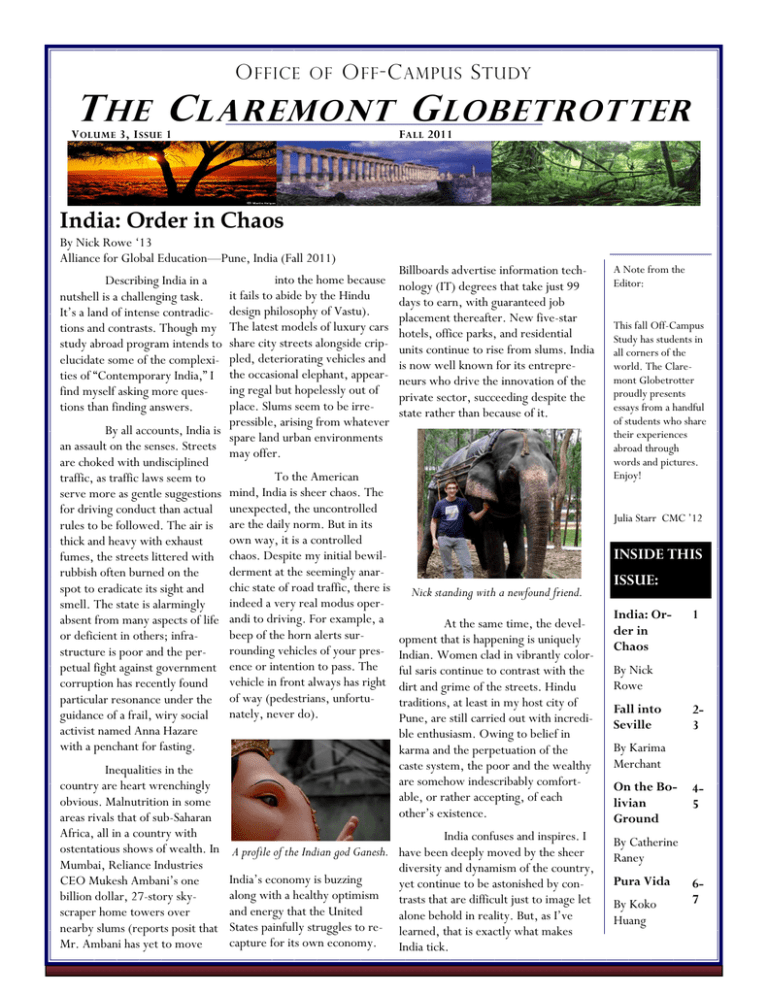
O FFICE OF O FF -C AMPUS S TUDY T HE C LAREMONT G LOBETROT TER V OLUME 3, I SSUE 1 F ALL 2011 India: Order in Chaos By Nick Rowe ‘13 Alliance for Global Education—Pune, India (Fall 2011) into the home because it fails to abide by the Hindu design philosophy of Vastu). The latest models of luxury cars share city streets alongside crippled, deteriorating vehicles and the occasional elephant, appearing regal but hopelessly out of place. Slums seem to be irrepressible, arising from whatever By all accounts, India is spare land urban environments an assault on the senses. Streets may offer. are choked with undisciplined To the American traffic, as traffic laws seem to mind, India is sheer chaos. The serve more as gentle suggestions for driving conduct than actual unexpected, the uncontrolled rules to be followed. The air is are the daily norm. But in its own way, it is a controlled thick and heavy with exhaust fumes, the streets littered with chaos. Despite my initial bewilderment at the seemingly anarrubbish often burned on the chic state of road traffic, there is spot to eradicate its sight and indeed a very real modus opersmell. The state is alarmingly absent from many aspects of life andi to driving. For example, a beep of the horn alerts suror deficient in others; infrarounding vehicles of your presstructure is poor and the perpetual fight against government ence or intention to pass. The vehicle in front always has right corruption has recently found particular resonance under the of way (pedestrians, unfortunately, never do). guidance of a frail, wiry social activist named Anna Hazare with a penchant for fasting. Describing India in a nutshell is a challenging task. It’s a land of intense contradictions and contrasts. Though my study abroad program intends to elucidate some of the complexities of “Contemporary India,” I find myself asking more questions than finding answers. Inequalities in the country are heart wrenchingly obvious. Malnutrition in some areas rivals that of sub-Saharan Africa, all in a country with ostentatious shows of wealth. In Mumbai, Reliance Industries CEO Mukesh Ambani’s one billion dollar, 27-story skyscraper home towers over nearby slums (reports posit that Mr. Ambani has yet to move Billboards advertise information technology (IT) degrees that take just 99 days to earn, with guaranteed job placement thereafter. New five-star hotels, office parks, and residential units continue to rise from slums. India is now well known for its entrepreneurs who drive the innovation of the private sector, succeeding despite the state rather than because of it. A Note from the Editor: This fall Off-Campus Study has students in all corners of the world. The Claremont Globetrotter proudly presents essays from a handful of students who share their experiences abroad through words and pictures. Enjoy! Julia Starr CMC ’12 INSIDE THIS Nick standing with a newfound friend. At the same time, the development that is happening is uniquely Indian. Women clad in vibrantly colorful saris continue to contrast with the dirt and grime of the streets. Hindu traditions, at least in my host city of Pune, are still carried out with incredible enthusiasm. Owing to belief in karma and the perpetuation of the caste system, the poor and the wealthy are somehow indescribably comfortable, or rather accepting, of each other’s existence. India confuses and inspires. I A profile of the Indian god Ganesh. have been deeply moved by the sheer diversity and dynamism of the country, India’s economy is buzzing yet continue to be astonished by conalong with a healthy optimism trasts that are difficult just to image let and energy that the United alone behold in reality. But, as I’ve States painfully struggles to re- learned, that is exactly what makes capture for its own economy. India tick. ISSUE: India: Order in Chaos 1 By Nick Rowe Fall into Seville 23 By Karima Merchant On the Bolivian Ground 45 By Catherine Raney Pura Vida By Koko Huang 67 P AGE 2 T HE C LAREMONT G LOBETROTTER FALL INTO SEVILLE B Y K ARIMA MERCHANT ‘13 S WEET B RIAR —S EVILLE ( FALL 2011) The Alcázar of Seville is one of Seville’s hidden gems. It is a royal palace surrounded by beautiful gardens. The upper levels of the Alcázar are still being used by the royal family as the official Seville residence today. The Courtyard of the Maidens or “Patio de las Doncellas” and the Baths of Lady María of Padilla or “Los Baños de Doña María de Padilla,” are two of Alcázar’s main highlights. P AGE 3 T HE C LAREMONT G LOBETROTTER The Metropol Parasol or the “mushroom” as the locals like to call it, was a result of an architecture design competition held by the city of Seville. The first place prize went to the Jurgen Mayer H Architects, a practice based in Berlin. The purpose of the competition was to relaunch the image of Seville around the world. Though the building is controversial due to its stark contrast to the rest of Seville’s traditional architecture, it has seen much success since its opening last Spring. Seville is one of the most important places for bullfights, or “Corrida de Toros,” in Spain. Though bullfighting is a very controversial part of Spanish culture, it remains a tradition in Seville and the Plaza de Toros de la Maestranza is known as one of the best places to watch bullfights in Spain. Ronda is a city in the Spanish province of Málaga, about an hour outside of Seville. Situated on top of mountains, Ronda is known as one of the prettiest white villages, or “pueblos blancos,” in Andalucía. In addition to being home to the most important bullring in Spain, Ronda was the primary influence for Ernest Hemingway’s novel The Sun Also Rises. Ronda’s most popular site is the New Bridge or “Puente Nuevo.” PAGE 4 On the Bolivian Ground By Catherine Raney CMC ‘13 SIT: Bolivia: Multiculturalism, Globalization & Change (Fall 2011) An indigenous woman wearing a wide skirt and long braids pushes a wheelbarrow of sliced pineapples that she will soon sell. She carries her child on her back using an aguallo, a colorfully-patterned cloth traditional in the Andes. Her dress represents both pride in her indigenous heritage and a refusal to westernize; yet she works in a modern urban setting. Women like her live throughout Cochabamba, my host city, and constantly remind me that Bolivia is a country of incredible complexity and contradictions. Self-defined as a pluri-national country with 36 recognized languages, Bolivians strive to construct a national identity without sacrificing the rich traditions of their indigenous populations. The people want development, but struggle in determining at what cost, and although the country has incredible natural resource wealth, it remains one of the most impoverished countries in the Western Hemisphere. An illustrative example of Bolivia struggling with its many contrasting goals can be viewed through analyzing the current debate surrounding the TIPNIS rainforest, a conflict that has dominated political discussion while I have lived here. The conflict began on August 15th when a group of over 1,000 indigenous people from TIPNIS territories began to march towards the capital, La Paz a trek of almost 400 miles. They marched in protest of the freeway that the Bolivian government planned to build directly through their territory, arguing that the freeway would lead to more immigration, industrialization and illegal deforestation; hurting their way of life A Bolivian mother carrying her daughter using a traditional aguallo. and causing irreversible damage to the Pachamama (Mother Earth). The government challenged their demands by explaining that the freeway would be an important step in modernizing the region and would consequently result in a higher quality of life. The debate turned violent on September 25, when 500 armed policemen descended on the marchers, and used violence to try and end the protest. Morally outraged, Bolivians displayed their support for the marches by participating in blockades and hunger strikes. T HE C LAREMONT G LOBETROTTER Living in Bolivia during this time was wild, upsetting, and inspirational. I could hardly believe that the Bolivian government, headed by its first indigenous president, Evo Morales, used violence against a group of ethically-sound protestors. There was talk of disappearances and injuries, and I felt a great frustration towards the government that was expected to bring hope and to those who have been oppressed for centuries. Then, after the protesters arrived in La Paz, Evo Morales announced that no one will touch TIPNIS. Plans for the highway were cancelled. This change demonstrated the power of communal action as well as the solidarity of the Bolivian people. Through winning national and international support, the marchers proved that the power does not lie with the Bolivian government, but with the people. I remember celebrating the triumph of a traditionally marginalized people, and discussing how it marks an important step in Bolivia’s struggle to determine its identity, future, and position on industrialization. Instead of choosing to pursue a western model of industrial development, the people decided to protect the biodiversity of the rainforest and the local traditions of indigenous groups that lived there. I feel lucky to have witnessed such a beautiful example of democratic power. Bolivia’s identify crisis has allowed me to examine the long-term effects of colonization, globalization, and poverty. I had learned about these concepts in CMC history, government and economics classes as well as through on campus clubs, but never before had the chance to see how they affect vulnerable populations in developing countries. Here I’ve learned how long and ugly the process of decolonizing is; even now, almost 200 years since the Spanish officially relinquished control, Bolivia has still not been able to overcome colonial ideas about development and diversity. For example, development is still viewed using purely western standards and there still exists a tendency to bypass dialogue and democratic processes. After visiting the mines in Potosi, once a city lined with silver but now one of the poorest cities in one of the poorest countries in Latin America, I’ve become more critical of globalization. There, I saw firsthand the exploitation of miners from Potosi, a vicious cycle that dates back to the 16th century when the Spanish discovered large silver deposits in the region. Page 5 T HE C LAREMONT G LOBETROTTER Bolivia’s failure to benefit from its vast amounts of natural resources in Potosi as well as in many other cities across the country made me wonder if wealthier societies will always benefit at the expense of the weaker ones. Who’s to blame for Bolivia’s failure to take advantage of its own natural resource wealth? This question has a thousand different answers, but none have helped the Bolivian government come up with solutions for how to end this cycle of poverty in which the majority of its people live. My study abroad experience in Bolivia exposed me to new realities, allowed me to overcome my ignorance of developing countries, and helped me analyze and better understand my politics, culture and self. In Bolivia, I’ve lived in an indigenous Quechua speaking family, explored the predominately Aymara city of El Alto, and studied the cosmovision - or way of seeing the world - of Andean and Amazonian cultures. Through all of these new experiences I’ve both become more critical of my own culture – too individually focused and success oriented - and developed a profound appreciation for it. A person doesn’t see the beauty of being able to call 911 until they live without it. I never realized how much I can trust the US’s governmental institutions until I came to Bolivia; here, as demonstrated in the TIPNIS march, government officials oppress instead of protect the people. Living in Bolivia has been very confusing for me; maybe that’s a reflection of how confused Bolivia is itself. There is one thing, however, that I have learned for sure, and it’s that TNC did not adequately prepare me for Salsa, Cueca, Morenada or any of the other hundred dances that every single Bolivian can dance with grace, style, and crazy amounts of swag. Catherine with her Quechuan-speaking host family in rural Bolivia. PAGE 6 The Claremont Globetrotter Pura Vida By Koko Huang ‘13 Duke OTS: Costa Rice - Global Health (Fall 2011) “¿Hola, como está?” Pura Vida. “Muchas gracias…” Pura Vida. “…insert any phrase here…” and the likely response is Pura Vida. From the moment my mom dropped me off at LAX to the moment I set foot in Costa Rica, all I have heard is the phrase Pura Vida. Literally translated, pura vida means “pure life”, but in Costa Rica, it can mean just about anything; think of the equivalent to “Aloha” in Hawaiian. Studying abroad is definitely more intense than I had expected but, although cliché, it has definitely opened my eyes to a whole new meaning of life. If there is anything that these past two months has taught me, it is the meaning of Pura Vida. For the past two months, I have been traveling all around the beautiful tropical country of Costa Rica with the OTS Global Health program through Duke University. I have been to the, city, the mountains and the rainforest and various indigenous communities all over the country, and no matter what part of the country I am in, Pura Vida seems to be the phrase that follows me. From the first day I stepped into downtown San Jose, I have been greeted with the typical Costa Rican hospitality and love. As I was dropped off in front of my host mother’s house, she embraced me, a complete stranger, with open arms and a big kiss on the cheek. Although I only spent three weeks with her, she made me feel like her little princess. Koko’s Mama‐Tica, Koko’s mom and Koko at her home stay in San Pedro, San Jose, Costa Rica. She brought me to various family parties and invited me to her brother’s wedding; she cooked dinner for me every night making sure I always had portions that were just a little too big. She even held my hand walking to school the first day as we crossed the busy roads of Costa Rica. My host mother showed me the first meaning of Pura Vida through her kindness, hospitality and all-around compassion. Mileka, one of the happiest indigenous girls that Koko worked with at the health clinic in Las Alturas, Costa Rica. Following the hospitality of my host mom, one experience that definitely engrained the meaning of Pura Vida in my head was visiting the various indigenous communities around Costa Rica. Throughout the many groups we visited, the hospitality and generosity I experienced was the same. One visit in particular, our trip to Las Alturas and our homestays with the Ngöbe indigenous groups there definitely reinforced the meaning of Pura Vida for me. Though the Ngöbe in this area live in an isolated community with houses made of wood, without proper roofing or hot water, they were still able to show us Americans the Costa Rican meaning of Pura Vida. They welcomed each of us, my 23 other comrades and myself, into their homes and provided us with some of the best Casados (typical Costa Rican food) I have ever tasted. The Ngöbe showed us through their hospitality and generosity that even when they had so little, they could still live by the Costa Rican Pura Vida philosophy. Furthermore, seeing the smiles on the little kids’ faces when we held a health clinic to teach them to wash their hands was the most rewarding thing I have ever seen. Although these kids did not have Playstations or Kinects to play with, they were all extremely happy, and being around these people that were so content with so little definitely taught me not to take things for granted. The Ngöbe have taught me to appreciate life, to live life under the Pura Vida philosophy. Page 7 The Claremont Globetrotter I came to Costa Rica looking to have a relaxing semester, wanting to surf and hang out at the beach, and I am getting more than I could have ever hoped for. I have been given a new meaning to live my life by. As a girl that once complained about having life too easy in the Claremont Bubble, never again will I complain about having too much or about being too fortunate. This experience, although not over, has already helped me grow as a person and understand that I am truly fortunate to be living in a world where we have so much, when there are people that are living with so little. I have come to appreciate the little things in life – that being able to wake up in the morning and seize the day is in itself enough for me to say Pura Vida. Some of the Ngobe indigenous kids standing in front of their home in Las Alturas, Costa Rica. The true meaning of Pura Vida in a snapshot. This is the view from one of our dorm‐ rooms at a field station in the rainforest. For more information on study abroad, please contact: Off-Campus Study Office Heggblade Center 850 Columbia Avenue Claremont, CA 91711 (909) 621-8267 fax: (909) 607-8690 studyabroad@cmc.edu

